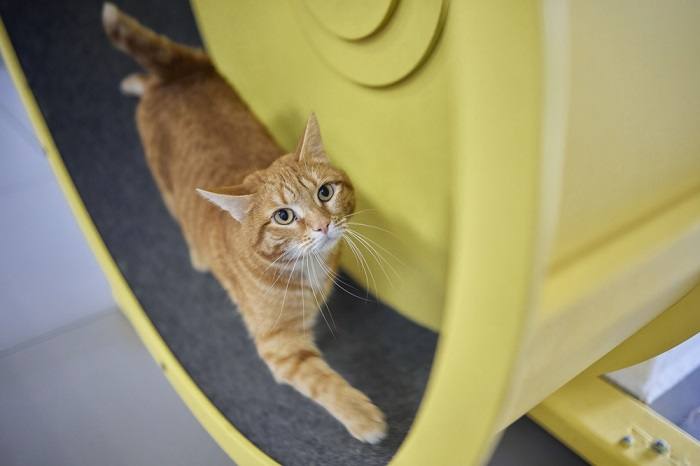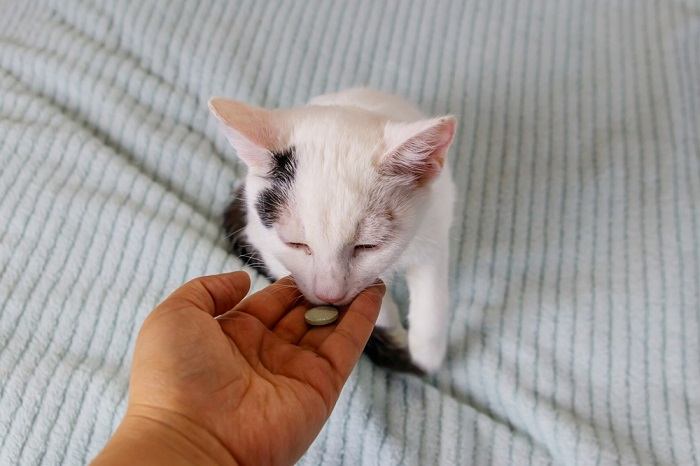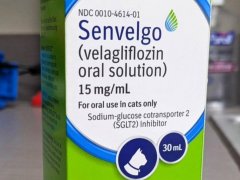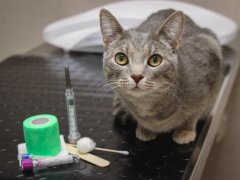
Glucosamine is a generic nutraceutical supplement that has been used for many years to help support joint function and mobility. It is available over the counter under many different brand names and formulas. Glucosamine is even used for cats.
Glucosamine for Cats Overview

In this article, you’ll learn what glucosamine is, how it functions in the body, when a supplement may be appropriate for your cat, what side effects to look for, and some frequently asked questions.
About Glucosamine for Cats

Good joint health is important, especially for aging cats.
Glucosamine as a commercial product is considered a nutraceutical or nutritional supplement. This is different from what we consider to be an actual drug. Commercial products are generally intended to supplement the body’s natural production and use of glucosamine.
In its natural form, glucosamine is a compound found in joint cartilage. Cartilage cells use glucosamine to produce other compounds called glycosaminoglycans (GAG) that keep joint fluid healthy. The health of cartilage relies heavily on the health of surrounding joint fluid.
Some additional roles glucosamine has in the body include the production of collagen and proteoglycans. These are the two main components that comprise cartilage. It also has some mild anti-inflammatory effects as a free radical scavenger.
Glycosaminoglycans (GAG) are also found in the mucus lining of the bladder and urinary tract. There are some theories that supplementing glucosamine may serve a role in bladder and urinary tract health.
Glucosamine for cats comes in many different forms and brands. The most common is Cosequin. Manufactured by Nutramax, Cosequin also contains chondroitin.
Most supplement companies will have a joint health supplement containing glucosamine, which is usually paired up with other joint health ingredients like chondroitin. Others include methylsulfonylmethane (MSM), green-lipped mussel (GLM), avocado-soybean unsaponifiables (ASU), omega fatty acids, and more.
Commercial glucosamine may be sourced in several ways. Shellfish is one of the most common. Green-lipped mussel (GLM), a specific mussel found off the coast of New Zealand, is another natural source. Since glucosamine is naturally found in joints, another can be found in byproducts of other animals used for food, like chicken and beef. Glucosamine can also be made synthetically.
Also Read: Osteoarthritis In Cats: Causes, Symptoms, & Treatment
What Does Glucosamine Do for Cats?

While studies on the efficacy of glucosamine in cats are spotty, many vets anecdotally see its benefits in their treatment.
Research proving the beneficial effects of glucosamine for joint support has been very conflicting. Some researchers see a statistical improvement in mobility or joint pain scores while others have not. However, products like Cosequin have been around for a very long time. Over that time, many veterinarians feel that anecdotally, glucosamine combination products do provide long-term help to cats suffering from joint health issues.
Similar things can be said about supplementing glucosamine for bladder and urinary tract health. GAG are components found in the protective lining of the bladder and urethra and glucosamine is involved with the production of GAG in the body. Therefore, glucosamine supplementation has been purported to help with maintaining bladder and urinary tract health in cats. This is especially true for cats that are susceptible to the umbrella of urinary conditions. Commonly referred to as feline lower urinary tract disease (FLUTD), these include feline idiopathic cystitis (FIC), feline urologic syndrome (FUS), or Pandora Syndrome.
However, research in this area is conflicting as well. In 2004, an article entitled “Oral glucosamine and the management of feline idiopathic cystitis” was published in the Journal of Feline Medicine and Surgery. The researchers found no significant difference in recovery between two groups of cats suffering from episodes of bladder inflammation where one group received glucosamine and another did not.
However, again, over a long-term period of months to years, many veterinarians believe that supplementing glucosamine can help many cats with chronic urinary tract disease.
Although proving the benefits of glucosamine has been difficult, glucosamine is considered to have a very high threshold of safety for use in cats. Rarely, some have recorded mild side effects. Because of this, many feel that glucosamine’s potential benefits greatly outweigh any possible detractors in using it as a daily supplement.
According to an article published by NC State in 2020, 45% of all cats experience some degree of arthritis. Furthermore, 90% of cats over the age of 10 years are affected by arthritis in some way. These findings were surprising to many since for a long time veterinary professionals assumed most cats don’t develop arthritis at all.
Now we know that far more cats suffer from arthritis than first thought, but they are far more clever about hiding it than dogs in many cases.
This is why many argue that starting a joint health supplement for any cat getting on into their senior years can be beneficial. Even if signs of arthritis are not obvious, it’s important to continue glucosamine. Likewise, even if noticeable changes or improvements are not obvious, many would argue to use glucosamine anyway.
Also Read: 8 Best Cat Foods For Urinary Tract Health
Side Effects of Glucosamine for Cats

Side effects of glucosamine are minimal, although mild GI upset is rarely seen.
Adverse effects of glucosamine for cats are very uncommonly reported. Side effects that have been reported include minor gastrointestinal effects like flatulence/gas and soft stools.
Because many glucosamine supplements are sourced from shellfish, a hypersensitivity reaction is possible in pets, just like in people with a shellfish allergy.
Any new type of food, supplement, or treat can cause unexpected digestive upset, so it’s always important to keep a close eye on your kitty after introducing something new. Oral overdoses are unlikely to cause significant medical problems.
If you are ever concerned that your kitty may have developed side effects while using a glucosamine supplement, or if an overdose is suspected, make sure to contact your veterinarian, the ASPCA Animal Poison Control Center (1-888-426-4435), or Pet Poison Helpline (1-855-764-7661) immediately for further advice.
Glucosamine has few suspected interactions with medications but there are a couple of precautions. Concurrent use with anticoagulant agents may enhance the effects of these drugs. The use of glucosamine in cats on treatments for diabetes like insulin may reduce the efficacy of these drugs in reducing blood sugar. Lastly, glucosamine may induce resistance to the injectable chemotherapy drug doxorubicin.
It is important to note that you should always fully review an ingredients list for any new supplement and discuss it with your vet before giving it to your cat. This is especially the case for cats with other chronic diseases or who are on medications.
There is no FDA regulation of supplement products in the United States. However, the National Animal Supplement Council (NASC) is a regulatory body that companies can become members of by adhering to strict labeling and production guidelines. These companies will carry the NASC Quality Seal on their products.
Looking for the NASC Quality Seal can be a way to look for supplements that must adhere to higher standards. It is similar to how you might look for the United States Pharmacopeia (USP) Verified Mark on human supplement products as a sign of manufacturing quality.
Also Read: Drug Poisoning In Cats: Causes, Symptoms, & Treatment
Glucosamine for Cats Dosage

Dosing off-label medicine for cats is tricky, so it is best to ask a vet for advice.
There is no labeled dosage of glucosamine for cats as glucosamine is used off-label for therapy. However, commonly accepted doses for joint health can range anywhere from 125-250mg per day. An off-label dose of 250mg per cat has been described for use in cats with feline idiopathic cystitis.
Products containing just glucosamine and/or chondroitin may initially take up to 4-6 weeks to show benefit.
Also Read: Urethral Obstruction In Cats: Causes, Symptoms & Treatment
Conclusion

Many cats suffer from joint problems, but are good at hiding it.
Glucosamine is a nutraceutical supplement that may be beneficial for cats to help support joint and urinary/bladder health. While official studies are conflicting, many veterinarians appreciate the anecdotal benefits of using glucosamine in cats.
Adverse effects of glucosamine supplementation are very uncommon. However, a large variety of unregulated products can make selecting the right supplement a challenge. It can always be helpful to ask your cat’s vet for advice.
Drug Dosing Disclaimer: We are only able to provide doses for medications that are FDA approved for use in cats and only as the label guidelines dictate. For medications that are used off-label we can only provide guidelines and safety information for use. Safe and appropriate dosing for off-label medications can only be determined by a primary care veterinarian.
We encourage you to work with your veterinarian to determine if a particular medication is appropriate for your cat. Changing or adjusting a dose for your cat on your own without consulting with a veterinarian can carry risk. We do not encourage use of medications prescribed for human use in pets without first consulting with a primary care veterinarian.
Frequently Asked Questions
Is glucosamine good for cats?
Many veterinarians do appreciate that glucosamine is good for cats. Anecdotally it can be beneficial for both joints and mobility as well as urinary bladder health. However, glucosamine is found in a wide variety of products. All product ingredients and manufacturing quality should be taken into account with any supplement product.
How quickly does glucosamine work in cats?
It may take up to 4-6 weeks to see noticeable benefits from a simple glucosamine supplement product. If you hope to see a noticeable improvement in your cat's mobility and joint health, you should typically use a product for an 8-week trial. This will give you ample time to see an expected difference.
How much glucosamine is safe for cats?
Many doses of glucosamine supplements for cats fall within the 125-250mg range. For example, the commonly-known brand Cosequin manufactured by Nutramax contains 125mg per capsule. One capsule of Cosequin is advised for cats under 10lb and two capsules (250mg) for cats over 10lb.
Very high doses or accidental overdoses are considered very unlikely to cause significant health concerns, aside from minor GI upset. Higher doses may not provide added beneficial effect, however.
Is glucosamine good for senior cats?
Many veterinarians consider glucosamine to be helpful for senior cats to help support their mobility. According to NC State, 90% of cats over the age of 10 years are affected by arthritis in some way whether they show visible signs or not. This highlights the potential benefit of providing a joint supplement to any senior cat.
Can glucosamine upset a cat's stomach
While considered rare, mild signs of digestive upset can be seen with glucosamine. At worst, this may include flatulence/gas and soft stools. It is important to remember that any new food or supplement can cause digestive upset.
Also, keep in mind that many joint health supplements contain ingredients other than just glucosamine, and it is important to review all ingredients a supplement contains. If you're uncertain about any ingredients a supplement contains, your veterinarian can help advise you.







